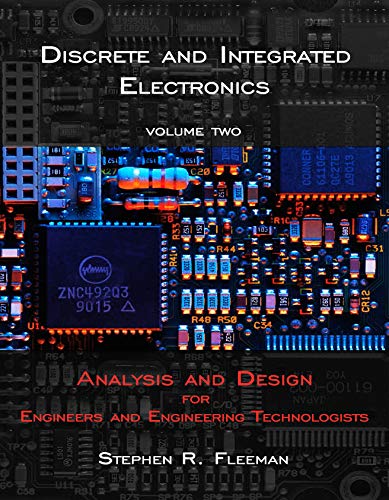Discrete and Integrated Electronics Volume Two : Analysis and Design for Engineers and Engineering Technologists
Discrete and Integrated Electronics Volume 2 is a textbook that was written to help anyone who is serious about learning the basic concepts in electronics which lead to the analysis and design of electronic circuits. A background in DC and a concurrent study of AC circuit theory is recommended. Familiarization of diodes, bipolar junction transistors, and field effect transistors is required. [These topics are covered in Discrete and Integrated Electronics (Volume 1 of 3)].
Illustrations augment the mathematics (mostly algebra) to help you grasp every concept. Narrated examples to help you understand the whys and not just the hows.
An inexpensive software program (purchased separately) called NI Multisim is used throughout. It allows you to draw an electrical schematic diagram and simulate the circuit operation. Its use is explained with many screen captures. NI (National Instruments) Multisim is extensively in industry and academia. In Discrete and Integrated Electronics, it is employed to show via simulation the accuracy of approximations and allow us to predict the behavior of electronic circuits.
Six chapters are included in Volume 2: Chapter 7 – BJT and FET Biasing, Chapter 8 – Voltage Amplifier Models, Chapter 9 – Inverting Voltage Amplifiers, Chapter 10 – Non-Inverting Voltage Amplifiers, Chapter 11 – Differential and Cascaded Amplifiers, and Chapter 12 – Frequency Response.
Chapter 7 provides a complete explanation of the analysis and design of DC biasing of BJTs and FETs. The importance of bias stability and the use of DC negative feedback and temperature compensation is explained. Chapter 8 discusses amplifier models (equivalent circuits) and their application to analyze any BJT, FET or integrated circuit amplifier. Chapter 9 covers inverting BJT, FET, and operational amplifier designs. Chapter 10 explores non-inverting BJT, FET, and operational amplifier designs. Chapter 11 describes differential, cascaded and instrumentation amplifier circuits. Topics such as differential voltage gain, common-mode rejection are examined. The use twisted shielded pairs and the active guard drive is presented. Chapter 12 examines the reason why bandwidth limitations occur in BJT, FET, and operational amplifier systems. AC circuit theory is needed to understand the filtering action that occurs.
The circuits are operational in almost every case. Multisim simulations are incorporated throughout to demonstrate the principles. The author has taught at the university/college level for 35 years and worked as an electrical engineer in aerospace for 31 years concurrently. You are invited to checkout his Amazon Author page.

English | 2020 | ASIN: B08FPYVF6M | 495 Pages | PDF | 15.82 MB
https://userupload.net/6ktdxmwdlp67
or
https://veryfiles.com/a049tlwokla1
or
https://mega4up.com/31nvwbnp40m7
or
http://s9.alxa.net/0abc1/xyza/Discr...Volume.Two.rar
Discrete and Integrated Electronics Volume 2 is a textbook that was written to help anyone who is serious about learning the basic concepts in electronics which lead to the analysis and design of electronic circuits. A background in DC and a concurrent study of AC circuit theory is recommended. Familiarization of diodes, bipolar junction transistors, and field effect transistors is required. [These topics are covered in Discrete and Integrated Electronics (Volume 1 of 3)].
Illustrations augment the mathematics (mostly algebra) to help you grasp every concept. Narrated examples to help you understand the whys and not just the hows.
An inexpensive software program (purchased separately) called NI Multisim is used throughout. It allows you to draw an electrical schematic diagram and simulate the circuit operation. Its use is explained with many screen captures. NI (National Instruments) Multisim is extensively in industry and academia. In Discrete and Integrated Electronics, it is employed to show via simulation the accuracy of approximations and allow us to predict the behavior of electronic circuits.
Six chapters are included in Volume 2: Chapter 7 – BJT and FET Biasing, Chapter 8 – Voltage Amplifier Models, Chapter 9 – Inverting Voltage Amplifiers, Chapter 10 – Non-Inverting Voltage Amplifiers, Chapter 11 – Differential and Cascaded Amplifiers, and Chapter 12 – Frequency Response.
Chapter 7 provides a complete explanation of the analysis and design of DC biasing of BJTs and FETs. The importance of bias stability and the use of DC negative feedback and temperature compensation is explained. Chapter 8 discusses amplifier models (equivalent circuits) and their application to analyze any BJT, FET or integrated circuit amplifier. Chapter 9 covers inverting BJT, FET, and operational amplifier designs. Chapter 10 explores non-inverting BJT, FET, and operational amplifier designs. Chapter 11 describes differential, cascaded and instrumentation amplifier circuits. Topics such as differential voltage gain, common-mode rejection are examined. The use twisted shielded pairs and the active guard drive is presented. Chapter 12 examines the reason why bandwidth limitations occur in BJT, FET, and operational amplifier systems. AC circuit theory is needed to understand the filtering action that occurs.
The circuits are operational in almost every case. Multisim simulations are incorporated throughout to demonstrate the principles. The author has taught at the university/college level for 35 years and worked as an electrical engineer in aerospace for 31 years concurrently. You are invited to checkout his Amazon Author page.

English | 2020 | ASIN: B08FPYVF6M | 495 Pages | PDF | 15.82 MB
https://userupload.net/6ktdxmwdlp67
or
https://veryfiles.com/a049tlwokla1
or
https://mega4up.com/31nvwbnp40m7
or
http://s9.alxa.net/0abc1/xyza/Discr...Volume.Two.rar
